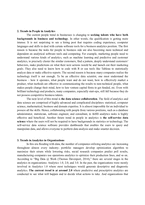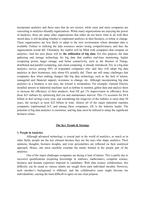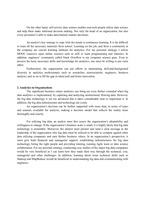빅데이터, 애널리틱스, 데이터과학의 현재와 미래
The most popular word that describes today’s analytics is machine learning. In almost every analytical application that companies develop today involves in machine learning techniques. For example, decision trees predict which employee is likely to leave or which customer will stop using a cell phone service. In customer recommendation systems, KNN (K Nearest Neighbors) suggests a series of products a particular customer will love to browse by making predictions based on the customer’s search history, ratings, and the shopping pattern of a similar customer. The machine learning techniques also enable the companies to predict which customer segment will most likely to buy a particular product, dramatically increasing sales. While there are many other techniques that are applied to the industries for various purposes, machine learning has been around for a while; it is derived from AI (Artificial Intelligence) which existed since approximately 1950’s. Back then, the AI needed detailed instructions for every action the machine was supposed to make. However, AI has been kept getting advanced as the engineers, developers and users want the machine to think and act by itself without needing their instructions or rules. And this desire to completely automate the machine is the main element that moves the trends in AI toward next stages, machine learning and deep learning. In the former stage, the machine is partially automated. Although it still requires most rules, the machine by itself can gather data, analyze them and make predictions under the preset rules, just as described in the examples above. One main concept in machine learning is unsupervised learning where the machine is not given the purpose of gathering data. Instead, the machine is asked to find an interesting and useful pattern or information for the user from the data it gathered. Finally, the next stage of machine learning is called deep learning. It is more advanced version that can handle the tasks with even less instructions or rules. The field of AI is still developing in the quest for complete automation.
The main advantage of machine learning and deep learning is automation: their ability to keep getting better and improve their performance by themselves by training with more data that become available. In businesses, this allows significant improvement in efficiency as the machines do not require “human-touch” as they react and adapt to the fast-changing environment. If a person is to perform data gathering and analysis for every change in data, it would be impossible for him to complete the task because the data is endlessly generated in this era of big data. What would be the amount of data trails that people visiting Amazon’s web page leave every day? Uncountable. The machine learning is a must in such a business environment.
빅데이터, 애널리틱스, 기계학습, 데이터사이언스와 연결된 사업, 전략, 관리 등에 관련된 내용들이며
최소 A- 이상만 올렸습니다.








 분야
분야


